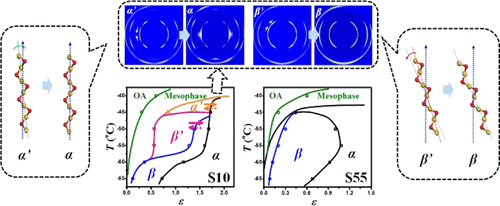当前位置:
X-MOL 学术
›
Macromolecules
›
论文详情
Our official English website, www.x-mol.net, welcomes your
feedback! (Note: you will need to create a separate account there.)
Stretch-Induced Intermediate Structures and Crystallization of Poly(dimethylsiloxane): The Effect of Filler Content
Macromolecules ( IF 5.1 ) Pub Date : 2020-01-16 , DOI: 10.1021/acs.macromol.9b02141 Jingyun Zhao 1, 2 , Pinzhang Chen 1 , Yuanfei Lin 1, 3 , Wei Chen 1 , Ai Lu 2 , Lingpu Meng 1 , Daoliang Wang 1 , Liangbin Li 1
Macromolecules ( IF 5.1 ) Pub Date : 2020-01-16 , DOI: 10.1021/acs.macromol.9b02141 Jingyun Zhao 1, 2 , Pinzhang Chen 1 , Yuanfei Lin 1, 3 , Wei Chen 1 , Ai Lu 2 , Lingpu Meng 1 , Daoliang Wang 1 , Liangbin Li 1
Affiliation

|
Stretch-induced crystallization (SIC) and structural transitions of poly(dimethylsiloxane) (PDMS) filled with different contents of nanosilica were studied with an in situ synchrotron radiation wide-angle X-ray scattering technique during uniaxial tensile deformation at temperatures from −40 to −65 °C. With low filler contents (10 and 25 phr), two different multistage kinetic pathways, namely, (i) amorphous–mesophase-α′−α forms and (ii) amorphous–mesophase-β′–β–α forms, are first observed during SIC of PDMS at −45 and −50 °C, respectively. However, with higher filler contents (40 and 55 phr), only α and β forms are observed during SIC of PDMS. The nonequilibrium SIC structural evolution diagrams of PDMS with different filler contents are constructed in strain–temperature space. Further cyclic tensile experiments demonstrate that the transitions of α′−α and β′−β are reversible and controlled by stress. Under preset strains, cooling results in the emergence of β, β′, α′, and α forms in sequence with the increase of the preset strains, which precisely follows the structural evolution diagram of SIC for PDMS with the low filler content. β′ and α′ are the independent crystal structures which occur before the SIC of β and α forms, respectively, rather than intermediate transient states for β–α transition. These results demonstrate the complexity of SIC with different structural intermediates in PDMS which is influenced not only by temperature and strain but also by the filler content and the kinetic process.
中文翻译:

拉伸诱导的中间结构和聚二甲基硅氧烷的结晶:填料含量的影响
用原位同步辐射辐射广角X射线散射技术研究了在-40到200°C的温度下单轴拉伸变形过程中填充不同含量的纳米二氧化硅的聚二甲基硅氧烷(PDMS)的拉伸诱导结晶(SIC)和结构转变。 −65°C。填料含量低(10和25 phr)时,有两种不同的多级动力学路径,即(i)非晶-中间相-α'-α形式和(ii)非晶-中间相-β '在PDMS的SIC分别于-45和-50°C时,首先观察到–β–α形式。但是,填料含量较高(40和55 phr)时,在PDMS的SIC过程中仅观察到α和β形式。在应变温度空间内构造了不同填料含量的PDMS的非平衡SIC结构演化图。进一步的循环拉伸实验表明,α'-α和β'-β的转变是可逆的,并且受应力控制。在预设应变下,冷却导致β,β',α'和α随预设应变的增加而依次形成,这正好遵循了低填充量PDMS的SIC的结构演化图。β'和α'是分别在β和α的SIC形成之前发生的独立晶体结构,而不是β–α跃迁的中间瞬态。
更新日期:2020-01-17
中文翻译:

拉伸诱导的中间结构和聚二甲基硅氧烷的结晶:填料含量的影响
用原位同步辐射辐射广角X射线散射技术研究了在-40到200°C的温度下单轴拉伸变形过程中填充不同含量的纳米二氧化硅的聚二甲基硅氧烷(PDMS)的拉伸诱导结晶(SIC)和结构转变。 −65°C。填料含量低(10和25 phr)时,有两种不同的多级动力学路径,即(i)非晶-中间相-α'-α形式和(ii)非晶-中间相-β '在PDMS的SIC分别于-45和-50°C时,首先观察到–β–α形式。但是,填料含量较高(40和55 phr)时,在PDMS的SIC过程中仅观察到α和β形式。在应变温度空间内构造了不同填料含量的PDMS的非平衡SIC结构演化图。进一步的循环拉伸实验表明,α'-α和β'-β的转变是可逆的,并且受应力控制。在预设应变下,冷却导致β,β',α'和α随预设应变的增加而依次形成,这正好遵循了低填充量PDMS的SIC的结构演化图。β'和α'是分别在β和α的SIC形成之前发生的独立晶体结构,而不是β–α跃迁的中间瞬态。











































 京公网安备 11010802027423号
京公网安备 11010802027423号